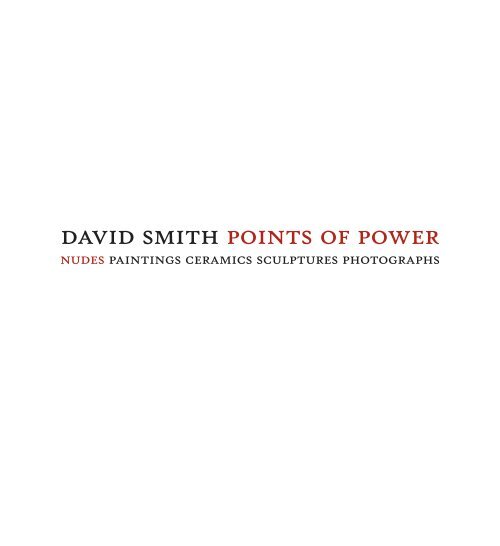Candida Smith – Points of Power
Excerpt from the catalogue “David Smith: Points of Power”, published by Galerie Gmurzynska on the occasion of an exhibition at the gallery space in St. Moritz, curated by the artist’s daughter Candida Smith.
Excerpt from the catalogue “David Smith: Points of Power”, published by Galerie Gmurzynska on the occasion of an exhibition at the gallery space in St. Moritz, curated by the artist’s daughter Candida Smith.
- No tags were found...
Create successful ePaper yourself
Turn your PDF publications into a flip-book with our unique Google optimized e-Paper software.
david smith points <strong>of</strong> power<br />
nudes paintings ceramics sculptures photographs
<strong>Candida</strong> and Rebecca <strong>Smith</strong> making a plaster horse, Bolton Landing, ca. 1961. Photograph by David <strong>Smith</strong>.
the points <strong>of</strong> power<br />
candida smith<br />
Where do you find the points <strong>of</strong> power? A child knows; an artist with the soul<br />
<strong>of</strong> a poet knows.<br />
When I was a child in the Adirondack Mountains, all the girls loved<br />
horses. One <strong>of</strong> my friends asked my father to show her how to draw a horse.<br />
He said, “No.” He never taught my sister or me how to draw or paint representationally.<br />
It limited the imagination. But my friend insisted until he could no<br />
longer refuse. He said, “You begin with the point <strong>of</strong> power.”<br />
The work in this exhibition appears to be my father’s most representational,<br />
but look some more. The artist, my father, David <strong>Smith</strong>, kept his distance.<br />
He gave his “models” no direction. The women here have no more<br />
concern for the artist or his view <strong>of</strong> them than would a horse or a leopard, and<br />
thus they have the same animal power and unconscious sensuality. They ask to<br />
be seen as something other than “figures.”<br />
Much <strong>of</strong> this work was created long after the photographs, in solitude,<br />
from my father’s point <strong>of</strong> power—his artistic identity—in the majestic mountaintop<br />
setting <strong>of</strong> his house and studio.<br />
When I was six years old and my sister seven, we asked our father for a<br />
horse. He said, “Of course, but you must first study and make a horse to scale.”<br />
We drew the bones, muscle groups (or we gave it our best effort), and learned<br />
where the movement came from; where the power was. He made an armature<br />
out <strong>of</strong> welded steel; we added muscles, flesh, and skin with plaster <strong>of</strong> Paris, old<br />
sheets, and burlap bags. Then, and only then, were we given Jo-Jo, our magnificent<br />
horse.<br />
21
At the age <strong>of</strong> twenty-three, my father bought land in the Adirondacks,<br />
with a vista <strong>of</strong> Lake George pooled between sweeping lines <strong>of</strong> mountain ridges,<br />
vast lines studded here and there with huge rock faces. It was expansive enough<br />
to fit his own vision. Kimon Nicolaides was then his teacher at the Art Students<br />
League. He and his book, The Natural Way to Draw, gave my father a technique,<br />
and the freedom, to make art that sprang from his own body. Eventually, large<br />
metal sculpture sprang naturally from him, an expression <strong>of</strong> his size and power.<br />
In the paintings, swooping lines cross and overlap in natural evocations<br />
<strong>of</strong> his body and the Bolton Landing environment. Individually, the paintings<br />
have a stillness, but as a group they spring into constant motion. The models—<br />
for the photographs and, later, for the paintings—are students, some perhaps<br />
students <strong>of</strong> dance. The paintings display women with a unique physicality.<br />
They appear to inhabit their bodies fully while remaining, at the same time,<br />
removed from their own sexuality. They communicate a self-contained awareness<br />
<strong>of</strong> the power they embody while being abstracted from the experience <strong>of</strong><br />
being naked before a man.<br />
The work here moves with rapid, unconscious association. It is constantly<br />
in flux, never static. Two excerpts from a long poem my father wrote in 1947<br />
evoke his response to both landscape and the nude:<br />
I have never looked at a landscape without seeing<br />
other landscapes<br />
I have never seen a landscape without visions<br />
<strong>of</strong> things I desire and despise<br />
. . . .<br />
22
Its black hills bristle with maiden fern<br />
its stones are Assyrian fragments<br />
it flows the bogside beauty <strong>of</strong> the river Liffey<br />
it is colored by Indiana gas green<br />
it is steeped in veritable indian yellow<br />
it is the place I’ve traveled to and never found<br />
The paintings are both landscapes and nude women, women he has never known<br />
and never will know. They represent loneliness and are at the same time portraits<br />
<strong>of</strong> his own anima. In his isolated setting above Lake George he was well<br />
accustomed to living alone.<br />
The photographs by Alexander Liberman were taken during the last weekend<br />
<strong>of</strong> his life, as he entertained his best friends and showed them these nude<br />
paintings with jubilation and pride.<br />
23
















